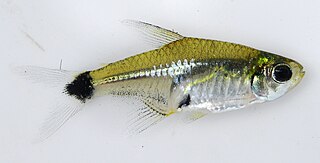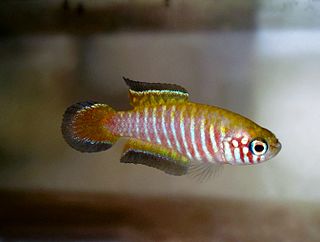
Crenicichla is a genus of cichlids native to South America commonly known as the pike cichlids. They are found in most tropical and subtropical freshwater habitats between the Andes and the Atlantic.

The Doradidae are a family of catfishes also known as thorny catfishes, raphael catfishes or talking catfishes. These fish are native to South America, primarily the Amazon basin and the Guianas.

Steindachneridion is a genus of South American pimelodid catfish.

The Hypoptopomatinae are a subfamily of catfishes of the family Loricariidae, composed of 17 genera and approximately 80 species. This subfamily represents about one-tenth of all loricariid species.
Microlepidogaster is a genus of armored catfishes native to South America.

Parotocinclus is a genus of fish in the family Loricariidae native to South America. This genus is distributed through almost all hydrographic systems in South America from the Guyana Shield drainages and Amazon Shield tributaries to the coastal drainages of eastern and southeastern Brazil, including the rio São Francisco basin. Most species have the caudal peduncle oval in cross section. It has been found that Characidium species may interact with P. maculicauda. The small Characidium will follow grazing P. maculicauda, which release particulate matter dislodged from the catfish's foraging.
Otothyris is a genus of armored catfishes endemic to Brazil.

The Araçuaí River is a river of Minas Gerais state in southeastern Brazil. The Araçuaí River flows through the Jequitinhonha Valley in the northeast of Minas Gerais, through the town of Araçuaí, which the river takes its name from. It is a tributary of the Jequitinhonha River, flowing south from its right bank. The confluence of the river is located at 16°45′45″S42°0′32″W. Tributaries include the Gravatá River, Setúbal River, Capivara River, Fanado River and the Itamarandiba River.
Nematocharax is a genus of freshwater fish in the family Characidae. It contains the single species Nematocharax venustus, which is endemic to Brazil, where it is found in the Jequitinhonha River basin. The males of this species can reach a length of 5.1 centimetres (2.0 in) SL while the females only grow to 3.5 centimetres (1.4 in) SL.

Serrapinnus is a genus of characins from tropical South America.

Cyphocharax is a genus of fish in the family Curimatidae native to South America.

Hypsolebias is a genus of small fish in the family Rivulidae that are endemic the Caatinga, Cerrado and nearby regions in Brazil. The greatest species richness is in the São Francisco River basin, but there are also species in the Tocantins, Jequitinhonha and Jaguaribe systems, as well as smaller river basins in northeastern Brazil. Like their relatives, Hypsolebias are annual killifish. The short-lived adults inhabit temporary waters like rain pools, laying their eggs in the bottom. As their habitat dries up the adults die, but the eggs survive and hatch when the water returns in the next season.

Simpsonichthys is a genus of killifish from the family Rivulidae the species of which are endemic to temporary freshwater habitats like ponds in the upper Paraná, upper Araguaia, upper Jequitinhonha and São Francisco basins on the central Brazilian Plateau. They are small annual killifish that reach up to 5.5 cm (2.2 in) in standard length.

The crested capuchin or robust tufted capuchin is a species of robust capuchin monkey. It is endemic to Brazil. It was formerly considered a subspecies of the black capuchin but is now considered by some to be a separate species.
Microlepidogaster discus is a species of armored catfish endemic to the Rio Jequitinhonha in southeastern Brazil.
Delturus brevis is a species of armored catfish endemic to the Rio Jequitinhonha basin in eastern Brazil.
Crenicichla ploegi is a species of cichlid native to South America. It is found swimming in Brazil. This species reaches a length of 28 cm (11 in).
Parotocinclus jequi is a species of catfish in the family Loricariidae. It is native to South America, where it occurs in the headwaters of the Jequitinhonha River basin in Brazil. It is found in areas with clear water, marginal vegetation, a substrate of rocks or pebbles, and a depth of 0.3 to 1.2 m. The species reaches 5.4 cm SL.
Simpsonichthys margaritatus is a species of killifish from the family Rivulidae. It is found in the Verde River floodplains, of the upper Paraná River basin in central Brazil.
Simpsonichthys espinhacensis is a species of killifish from the family Rivulidae. It is found in the upper Jequitinhonha River basin in Minas Gerais, eastern Brazil. The specific name refers to the Espinhaço Mountains where the known range of this species lies.










